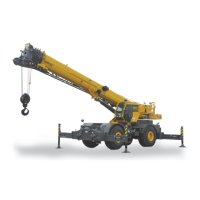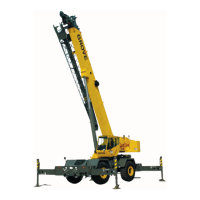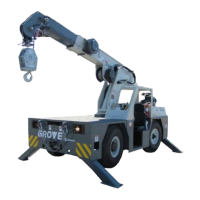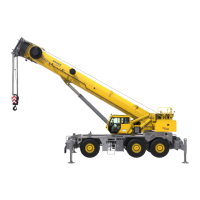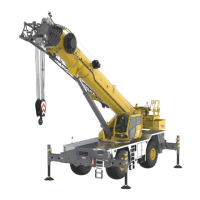Grove Published 01-29-2015, Control # 512-01 2-75
TMS700E SERVICE MANUAL HYDRAULIC SYSTEM
7. Insert a spanner wrench into the holes provided and turn
the head counter clockwise to remove. If the head is
difficult to remove, tap the head with a plastic mallet
while turning.
8. With the rod still supported, gently pull the piston from
the barrel being careful not to damage the internal
threads. Place the rod on a surface that will not damage
the chrome.
9. Remove the setscrews located near the top of the
piston.
10. Insert a spanner wrench into the holes on the face side
of the piston.
11. Turn the piston counter clockwise to remove.
NOTE: Arranging discarded seals and rings in the order of
disassembly will aid in installation of new seals and
rings. Pay attention to how each seal and ring is
installed to avoid installing replacement seals and
rings improperly.
12. Remove the wear rings and ring seal from the piston.
13. Remove the O-rings, backup ring, wear rings, ring seal
and wiper ring from the head.
Inspection
1. Inspect the rod. There should be no scratches or pits
deep enough to catch the fingernail. Pits that go to the
base metal are unacceptable. Chrome should be
present over the entire surface of the rod. If lack of
chrome on rod, the rod should be replaced.
2. Inspect rod for straightness. Determine if it can be
straightened or must be replaced.
3. Inspect the head. Visually inspect the inside bore for
scratching or polishing. Deep scratches are
unacceptable. Polishing indicates uneven loading, and
the bore should be checked for out-of-roundness.
4. Inspect the piston. Visually inspect the outside surface
for scratches or polishing, Deep scratches are
unacceptable. Polishing indicates uneven loading, and
the diameter should be checked for out-of roundness.
5. Inspect the barrel carefully for scoring. If barrel is
scored, it must be repaired or replaced.
CAUTION
When removing seals and rings, avoid scratching the
grooved and gland surfaces.
Reference Only

